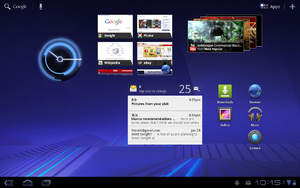Android Honeycomb
Third version of the Android operating system
Operating system
Screenshot

Android 3.0 running on a Motorola Xoom
Android Honeycomb is the codename for the third major version of Android, designed for devices with larger screen sizes, particularly tablets, however has been unofficially ported to the Nexus One.[2] It is the eighth version of Android and is no longer supported. Honeycomb debuted with the Motorola Xoom in February 2011.[3][4] Besides the addition of new features, Honeycomb introduced a new so-called "holographic" user interface theme and an interaction model that built on the main features of Android, such as multitasking, notifications and widgets.[5][6]
Features
New features introduced in Honeycomb include the following:
- The Email and Contacts apps use a two-pane UI.
- The Gallery app now lets users view albums and other collections in full-screen mode, with access to thumbnails for other photos in a collection.
- The Browser app replaces browser windows with tabs, adds an incognito mode for anonymous browsing, and presents bookmarks and history in a unified view, among other features.
- A redesigned keyboard to make entering text easier on large-screen devices such as tablets.
- A Recent Apps view for multitasking.
- Customizable home screens (up to five).
See also
- Android version history
- iOS 4
- Mac OS X Snow Leopard
- Windows Phone 7
- Windows 7
References
- ^ Metz, Cade (March 24, 2011). "Steve Jobs vindicated: Google Android is not open". Archived from the original on September 10, 2019. Retrieved June 23, 2018.
- ^ "Android Honeycomb Ported to the Nexus One!". February 21, 2011. Archived from the original on April 15, 2021.
- ^ "What is Android 3.0 Honeycomb? - Definition from WhatIs.com". Archived from the original on April 30, 2020. Retrieved July 29, 2016.
- ^ "Google announces Android 3.1, available on the Verizon Motorola Xoom today". Engadget. Engadget. Archived from the original on June 29, 2019. Retrieved July 29, 2016.
- ^ "The history of Android". Ars Technica. Archived from the original on August 1, 2016. Retrieved September 13, 2015.
- ^ John Brandon. "Android 3.0 (Honeycomb) review". TechRadar. Archived from the original on June 25, 2018. Retrieved September 13, 2015.
External links
 Media related to Android Honeycomb at Wikimedia Commons
Media related to Android Honeycomb at Wikimedia Commons- Official website

- v
- t
- e
Android
development
| Development tools |
| ||||
|---|---|---|---|---|---|
| Integrated development environments (IDE) |
| ||||
| Languages, databases | |||||
| Virtual reality (VR) | |||||
| Events, communities |
| Pixel | |
|---|---|
| Nexus | |
| Play edition |
|
distributions
- AliOS
- Android-x86
- AOKP
- Baidu Yi
- Barnes & Noble Nook
- CalyxOS
- ColorOS
- CopperheadOS
- EMUI
- Magic UI
- Fire OS
- Flyme OS
- GrapheneOS
- LeWa OS
- LineageOS
- LiteOS
- Meta Horizon OS
- MicroG
- MIUI
- MIUI for POCO
- Nokia X software platform
- OmniROM
- OPhone
- OxygenOS
- PixelExperience
- Pixel UI
- Replicant
- Resurrection Remix OS
- SlimRoms
- TCL UI
- Ubuntu for Android
- XobotOS
- ZUI
- SuperSU
- Magisk
- Kingo Root
 Category:Android development
Category:Android development Category:Mobile telecommunications
Category:Mobile telecommunications Software portal
Software portal Telecommunication portal
Telecommunication portal
















